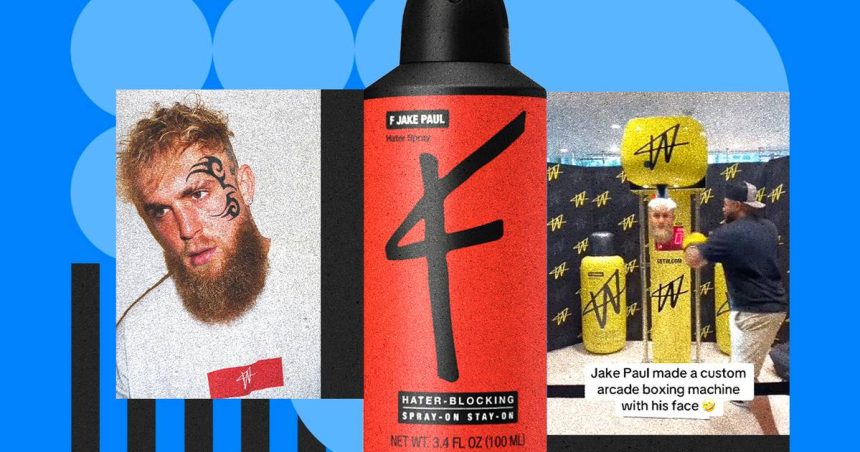At a press conference during Fanatics Fest earlier this year, Jake Paul and Mike Tyson took questions from a moderator and crowd of boxing fans to promote their much-anticipated fight on November 15.
Paul, the influencer turned professional athlete, was not a crowd favorite. About halfway through the event, a chant directed toward him—an expletive followed by his first and last name—swelled to top volume, with Paul himself joining in.
Little did the haters know, they may have inspired Paul’s next marketing stunt for his personal-care brand, W. On November 12, at an open workouts event, Paul announced a new iteration of W by Jake Paul Body Spray, adorned with an “F” where the brand’s signature W usually sits.
Paul is no stranger to using his haters as a way to get people talking, W’s VP of Brand, Matt Rogers, told Marketing Brew. Earlier this year, ahead of Paul’s fight against Mike Perry, W created a punching-bag machine retrofitted with Paul’s face and invited fans and haters to try to see what it’s like to punch him in the face.
For the brand, leaning into the haters is a tried-and-true tactic to remain subversive and stand out.
“It’s fun to root against someone,” Rogers said. “It’s fun to root for someone. When we’re able to harness that, it’s disarming.”
Attention, please
For the five-month-old brand, making a “splash on the internet” is a priority, Rogers told us, which means focusing on amplifying social conversation.
“We’re a social-first brand and are really competing with everything else that’s going on on the internet on any given day,” Rogers said. “We realize that you have to do things that are really interesting and do things that feel really big, even if you’re a smaller brand, and that’s how we plan to grow our audience.”
W’s previous marketing stunts have included sending video packages to influencers showing deepfakes of them promoting the brand; having influencer Rubi Rose spray men on the beach in a video called “Stankwatch;” and Paul poking fun at companies promoting themselves on LinkedIn in a video posted to LinkedIn and other social media platforms. It all calls back to the persona Paul built in his early YouTube career bolstered through dangerous pranks, brash humor, and potentially damaging controversies, including allegations of sexual assault, which he has denied.
It seems the strategy is generating results, at least when it comes to organic tagged posts the brand sees, Woodie Hillyard, CEO and co-founder of W, said.
“Every month since we’ve launched, we’ve had more than 1,000 organic tagged posts on Instagram of people taking photos of the product, calling out the brand,” Hillyard told Marketing Brew. The company says these posts have generated 194 million impressions.
Get marketing news you’ll actually want to read
Marketing Brew informs marketing pros of the latest on brand strategy, social media, and ad tech via our weekday newsletter, virtual events, marketing conferences, and digital guides.
Rogers said Paul’s personal notoriety and the brand’s eclectic lineup of ambassadors (which W refers to as co-owners) “gives us the ability to be a bit more audacious right out of the gate,” he told us.
“With Jake at the helm and the co-owners that we have involved…that puts us in a position to kind of behave more like a creator and less like a traditional brand,” Rogers said.
That means that even when the brand is putting on IRL activations, Rogers is focused on making sure they can serve a purpose for an online audience, too. When W created the punching-bag machine, “that was designed to live in the real world and create an action where people wanted to film it.” Rogers told us.
“If you’re going to do something that lives in the world, it should have a goal of making noise online,” Rogers said. “Everyone consumes on the internet, right? No one’s going to walk past a billboard and make their purchasing decision, but if that billboard ends up on their feed later, you have a better chance at it.”
Fight to the finish
For the Tyson-Paul fight and the surrounding events, W is also taking advantage of the naturally presented rivalry to encourage emotional responses from fans and haters alike.
To further promote the fight and the brand, W closely replicated Tyson’s iconic 2007 Supreme campaign, instead placing Paul’s image and the W logo on posters plastered around LA and New York. Rogers said the idea was borne out of playing on the fight’s rivalry by referencing the original image, with the goal of encouraging passers-by to snap photos of the posters once they discover them, whether they like them or not.
Rogers’s philosophy, he told us, is that people often expect brands to elicit sentiments of happiness and positivity, which he said can feel forced or not genuine. Why not give them something else to feel?
“Just like anything, you need some controversy. You need to do something that doesn’t just feel pleasant to everyone,” Rogers said. “People want to feel something towards a brand, and if that’s hate, I don’t really think anyone takes it so seriously that it’s true hate. But it is something valuable when someone amplifies something for you based [on] their emotional response to what you’re doing.”
Ultimately, Rogers said, he’d rather that W inspire emotion of any kind than fly under the radar online.
“I think the worst thing that can happen is someone says nothing on the internet about your brand,” Rogers said.
Read the full article here










